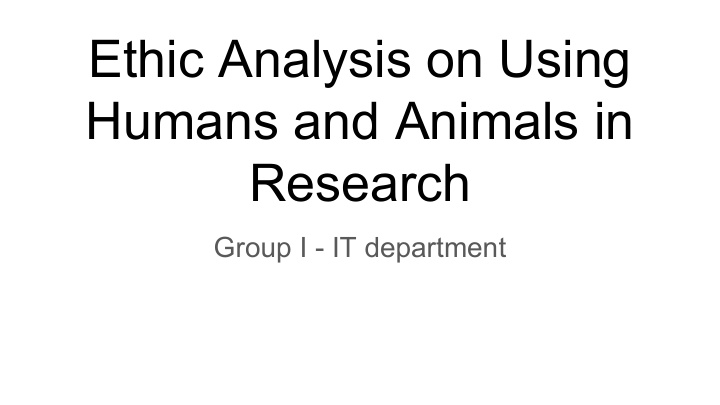



Ethic Analysis on Using Humans and Animals in Research Group I - IT department
Problem More than 33 million people today have HIV and risk contracting AIDS if they do not receive effective inhibitor medications. A great deal of research is being conducted to find a cure for HIV/AIDS using chimpanzees which, besides man, is the only animal that can get HIV/AIDS. You are a member of an ethics committee on animal experiments that is to ethically evaluate a research project aiming to test the effectiveness of a potential vaccine . The researchers inform the committee that the vaccine’s effect needs to be tested on advanced AIDS, which means that the chimpanzees will be in very poor health when the actual experimenting begins. What ethically significant aspects do you feel should be considered to ethically evaluate whether this experiment should be approved?
Question 1 Will there be any ethical problems or conflicts in the context, in the organisation or in the group where your decision will be applied or your solution will be used (e.g. your research findings)? ● Testing on animals implies giving chimpanzees a terminal disease – they will suffer badly. ● Not testing on animals on the other hand may at least prevent insight for further science The purpose of the research might justify the expected suffering of the animals.
Question 2 Will your decision or solution cause any ethical problems or conflicts? ● Testing on animals implies giving chimpanzees a terminal disease – they will suffer badly. ○ The purpose of the research might justify the expected suffering of the animals. ○ According to the law the project must be ethically reviewed
Question 3 Are there any alternatives to your solution? ● Testing on already infected humans. However, this is against Swedish law. ● Alternatives may take time, meanwhile people will die: ○ Find already infected chimpanzees. ○ Many researchers try to find animal-free methods that allow them to reach results that are equally dependable (e.g computer simulations). ○ Gene manipulate an animal with less intrinsic value into being receptive for HIV and then infect/test on that*. ● Our decision to use alternatives may affect the decision of other involved boards: the clinical trial requires an approval from Swedish Medical Products Agency. *Using a lower intrinsically valued animal might justify trials on chimpanzees later on.
Question 4 What groups, individuals, organisations, etc, will in any way be affected by or have a stake in the development, use, application or mere existence of your decision and solution? (Including society at large and the environment.) ● Infected people ● Infected chimpanzees ● The research group ● Some pharmaceutical company ● Me as a researcher
Question 5 What values, interests, duties, standpoints and attitudes are involved in the use of your solution and of the possible alternatives? ● As a researcher, I have a duty to try to contribute to the knowledge in this area. ● Animal rights organizations (and likewise) will complain about making healthy animals sick for the cause of this research. ● Possible financial interests (researchers, companies).
Question 6 What effects will your solution (and the alternatives) have on each of these values? What are the strengths/possibilities and the weaknesses/risks of each solution to each value? Will these solutions fit certain values and conflict with others? What values and how? ● We have a duty to contribute this knowledge, as this will (potentially) save millions of lives. ● However, this conflicts with values and ethics related to animal rights.
Question 7 What will you do to make sure that the use of the solution will be optimal with regards to ethical aspects? For instance, adapt the design of the product, use of research methods, cooperation with industry, information to stakeholders, etc? How exactly are you going to succeed with this? ● Now you have chimpanzees – don’t overuse them. ○ Partial or pilot study to evaluate the potential effectiveness. ○ Reduce the number of animals to be used. ● Try to be sure that the results are good enough so far, that you are confident in trying them on animals. ● If possible, we should use previous data about infected chimpanzees.
Questions?
Recommend
More recommend